Training and Development Report: Performance Gap, TNA, and Benefits
VerifiedAdded on 2022/11/13
|9
|1740
|81
Report
AI Summary
This report delves into the critical aspects of training and development within an organizational context. It begins by defining the concept of a performance gap and its implications for businesses, emphasizing the difference between current performance and desired goals. The report then explores the potential negative consequences of inadequate training, such as low production rates, high employee turnover, unsafe working conditions, and increased business expenses. Conversely, it highlights the numerous benefits of effective training programs for both employees and employers, including improved employee performance, reduced turnover, fostered innovation, and increased employee satisfaction. A significant portion of the report is dedicated to Training Needs Analysis (TNA), outlining the steps involved in identifying training needs, conducting gap analysis, assessing training options, and reporting findings. Finally, the report evaluates the benefits and resource implications of various training approaches, such as coaching, simulators, and role-playing, providing valuable insights into their effectiveness and suitability for different training objectives.
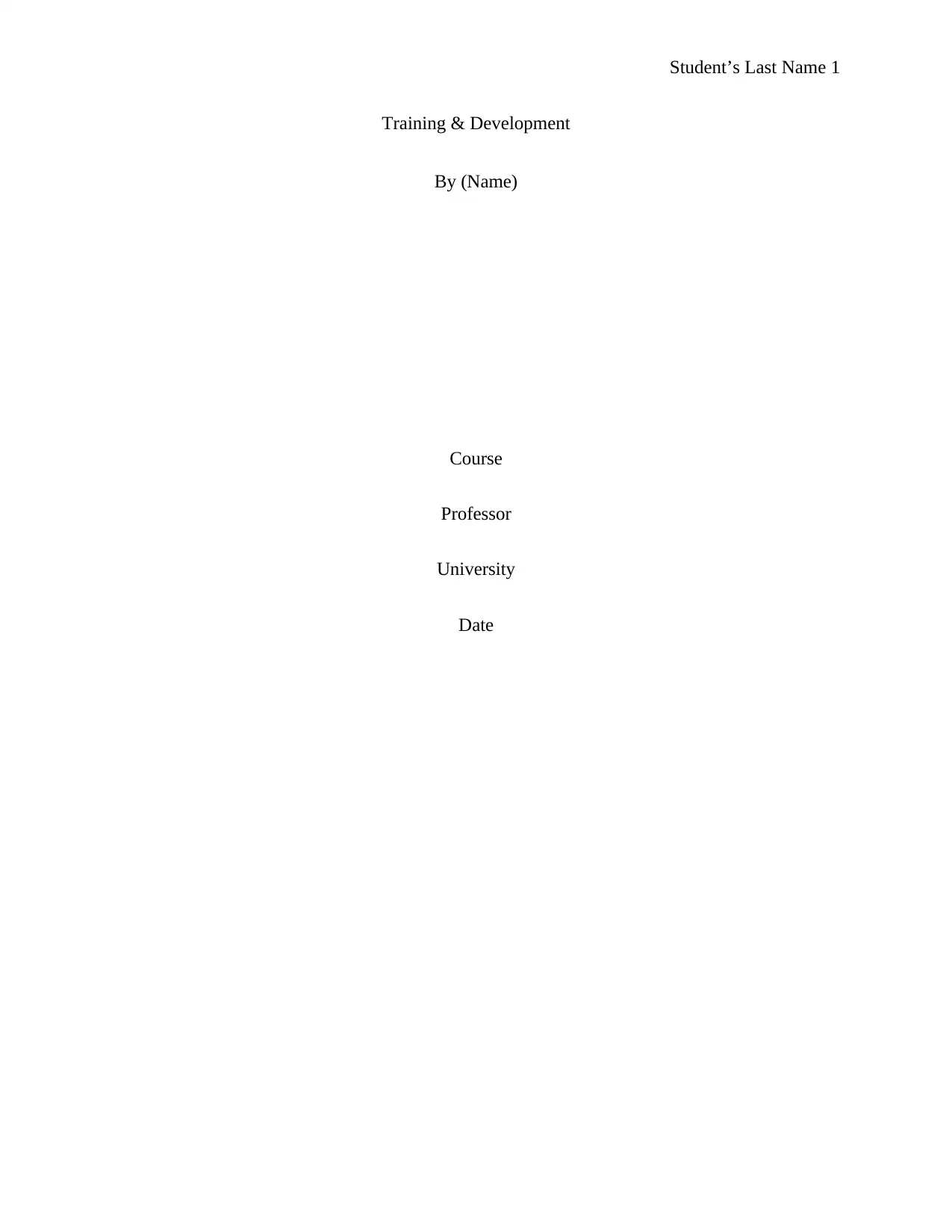
Student’s Last Name 1
Training & Development
By (Name)
Course
Professor
University
Date
Training & Development
By (Name)
Course
Professor
University
Date
Paraphrase This Document
Need a fresh take? Get an instant paraphrase of this document with our AI Paraphraser
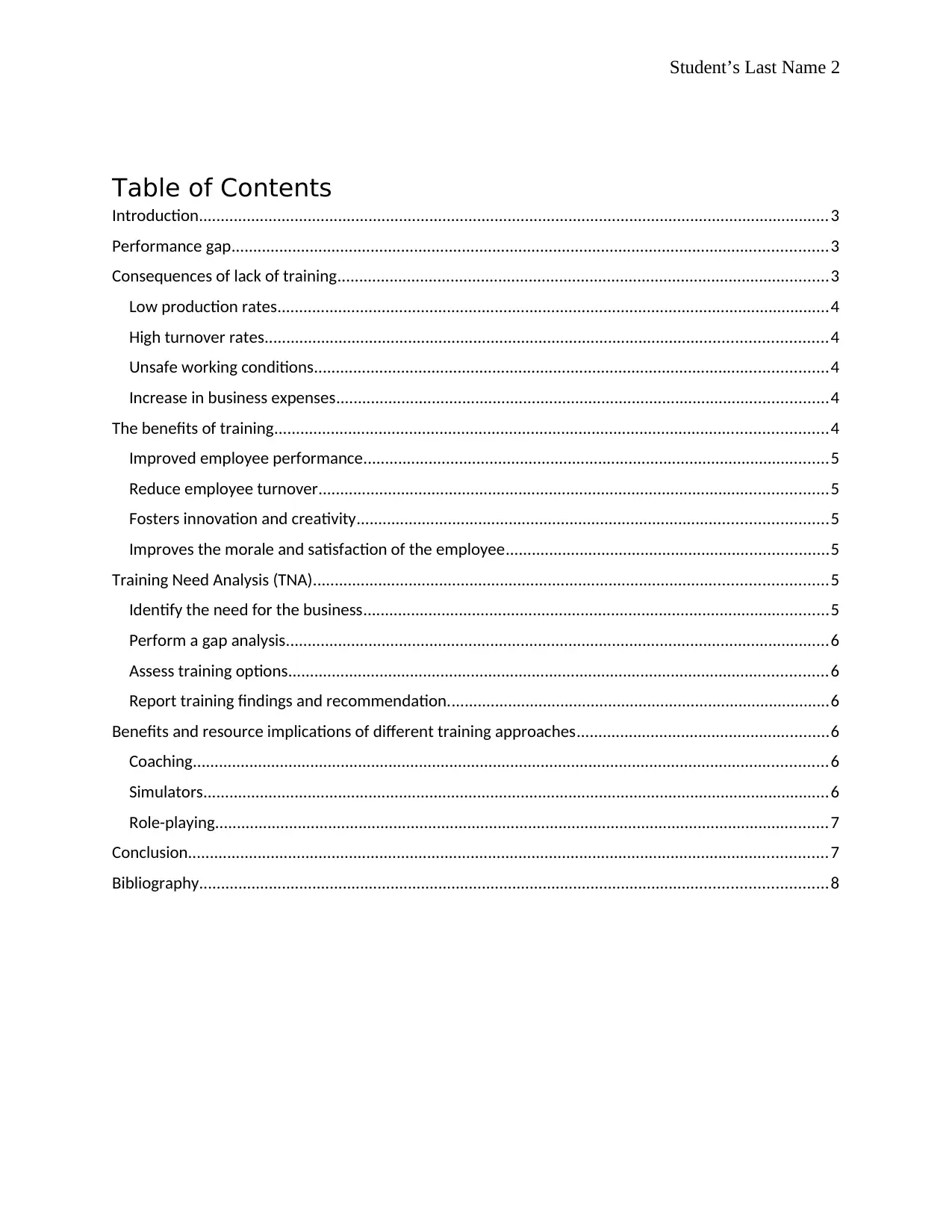
Student’s Last Name 2
Table of Contents
Introduction.................................................................................................................................................3
Performance gap.........................................................................................................................................3
Consequences of lack of training.................................................................................................................3
Low production rates...............................................................................................................................4
High turnover rates.................................................................................................................................4
Unsafe working conditions......................................................................................................................4
Increase in business expenses.................................................................................................................4
The benefits of training...............................................................................................................................4
Improved employee performance...........................................................................................................5
Reduce employee turnover.....................................................................................................................5
Fosters innovation and creativity............................................................................................................5
Improves the morale and satisfaction of the employee..........................................................................5
Training Need Analysis (TNA)......................................................................................................................5
Identify the need for the business...........................................................................................................5
Perform a gap analysis.............................................................................................................................6
Assess training options............................................................................................................................6
Report training findings and recommendation........................................................................................6
Benefits and resource implications of different training approaches..........................................................6
Coaching..................................................................................................................................................6
Simulators................................................................................................................................................6
Role-playing.............................................................................................................................................7
Conclusion...................................................................................................................................................7
Bibliography................................................................................................................................................8
Table of Contents
Introduction.................................................................................................................................................3
Performance gap.........................................................................................................................................3
Consequences of lack of training.................................................................................................................3
Low production rates...............................................................................................................................4
High turnover rates.................................................................................................................................4
Unsafe working conditions......................................................................................................................4
Increase in business expenses.................................................................................................................4
The benefits of training...............................................................................................................................4
Improved employee performance...........................................................................................................5
Reduce employee turnover.....................................................................................................................5
Fosters innovation and creativity............................................................................................................5
Improves the morale and satisfaction of the employee..........................................................................5
Training Need Analysis (TNA)......................................................................................................................5
Identify the need for the business...........................................................................................................5
Perform a gap analysis.............................................................................................................................6
Assess training options............................................................................................................................6
Report training findings and recommendation........................................................................................6
Benefits and resource implications of different training approaches..........................................................6
Coaching..................................................................................................................................................6
Simulators................................................................................................................................................6
Role-playing.............................................................................................................................................7
Conclusion...................................................................................................................................................7
Bibliography................................................................................................................................................8
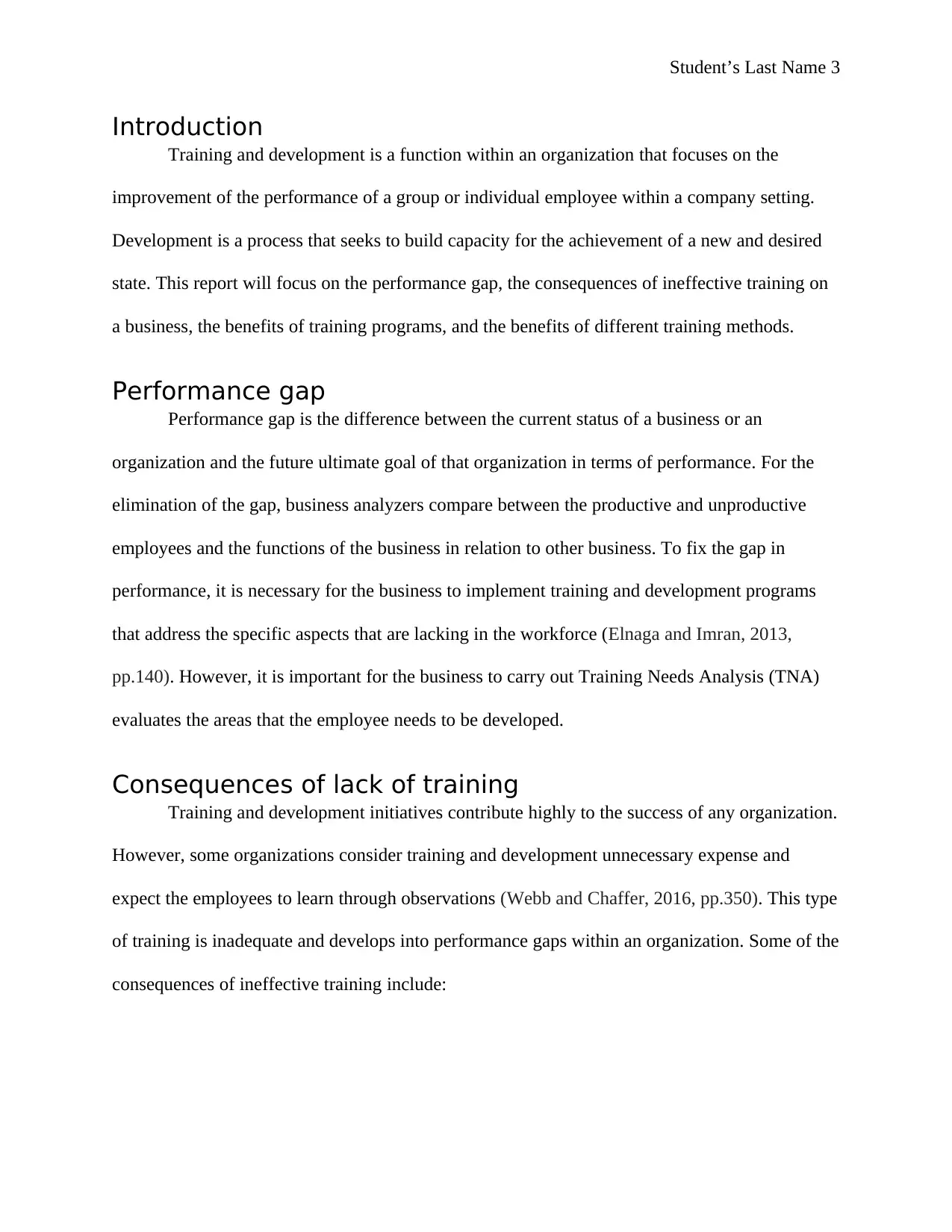
Student’s Last Name 3
Introduction
Training and development is a function within an organization that focuses on the
improvement of the performance of a group or individual employee within a company setting.
Development is a process that seeks to build capacity for the achievement of a new and desired
state. This report will focus on the performance gap, the consequences of ineffective training on
a business, the benefits of training programs, and the benefits of different training methods.
Performance gap
Performance gap is the difference between the current status of a business or an
organization and the future ultimate goal of that organization in terms of performance. For the
elimination of the gap, business analyzers compare between the productive and unproductive
employees and the functions of the business in relation to other business. To fix the gap in
performance, it is necessary for the business to implement training and development programs
that address the specific aspects that are lacking in the workforce (Elnaga and Imran, 2013,
pp.140). However, it is important for the business to carry out Training Needs Analysis (TNA)
evaluates the areas that the employee needs to be developed.
Consequences of lack of training
Training and development initiatives contribute highly to the success of any organization.
However, some organizations consider training and development unnecessary expense and
expect the employees to learn through observations (Webb and Chaffer, 2016, pp.350). This type
of training is inadequate and develops into performance gaps within an organization. Some of the
consequences of ineffective training include:
Introduction
Training and development is a function within an organization that focuses on the
improvement of the performance of a group or individual employee within a company setting.
Development is a process that seeks to build capacity for the achievement of a new and desired
state. This report will focus on the performance gap, the consequences of ineffective training on
a business, the benefits of training programs, and the benefits of different training methods.
Performance gap
Performance gap is the difference between the current status of a business or an
organization and the future ultimate goal of that organization in terms of performance. For the
elimination of the gap, business analyzers compare between the productive and unproductive
employees and the functions of the business in relation to other business. To fix the gap in
performance, it is necessary for the business to implement training and development programs
that address the specific aspects that are lacking in the workforce (Elnaga and Imran, 2013,
pp.140). However, it is important for the business to carry out Training Needs Analysis (TNA)
evaluates the areas that the employee needs to be developed.
Consequences of lack of training
Training and development initiatives contribute highly to the success of any organization.
However, some organizations consider training and development unnecessary expense and
expect the employees to learn through observations (Webb and Chaffer, 2016, pp.350). This type
of training is inadequate and develops into performance gaps within an organization. Some of the
consequences of ineffective training include:
⊘ This is a preview!⊘
Do you want full access?
Subscribe today to unlock all pages.

Trusted by 1+ million students worldwide

Student’s Last Name 4
Low production rates
Productivity declines when the workforce does not know what their job really entails.
Some organization delegate training programs to other employees who have more experience on
the job (Kum, Cowden and Karodia, 2014, pp.58). However, such employees are not given
enough time to carry out training programs. They rush through them and not provide proper
insight to the new employees.
High turnover rates
Most employees are interested in effective work performance in order to develop a
feeling of pride and self-actualization and get promoted. When employees do not understand
how to do their jobs, such goals cannot be attained (Sung and Choi, 2014, pp.400). This may
reduce the morale of the employees, consequently resulting in the employees seeking other
rewarding ventures.
Unsafe working conditions
Untrained employees are more susceptible to get injuries in the line of their work (Callan,
Johnston and Poulsen, 2015, pp.299). Inadequate training can result in accidents that may be
catastrophic and detrimental to the organization as a whole.
Increase in business expenses
An organization that does not train its staffs can incur expenses such as compensation to
the injured employees, high cost of medical attention, and the cost of litigation occasioned by
lawsuits from injured workers or consumers who bought defective products.
The benefits of training
Training and development present an opportunity to develop the the skills and
competency of employees. Some of the benefits to both the employer and the employee include:
Low production rates
Productivity declines when the workforce does not know what their job really entails.
Some organization delegate training programs to other employees who have more experience on
the job (Kum, Cowden and Karodia, 2014, pp.58). However, such employees are not given
enough time to carry out training programs. They rush through them and not provide proper
insight to the new employees.
High turnover rates
Most employees are interested in effective work performance in order to develop a
feeling of pride and self-actualization and get promoted. When employees do not understand
how to do their jobs, such goals cannot be attained (Sung and Choi, 2014, pp.400). This may
reduce the morale of the employees, consequently resulting in the employees seeking other
rewarding ventures.
Unsafe working conditions
Untrained employees are more susceptible to get injuries in the line of their work (Callan,
Johnston and Poulsen, 2015, pp.299). Inadequate training can result in accidents that may be
catastrophic and detrimental to the organization as a whole.
Increase in business expenses
An organization that does not train its staffs can incur expenses such as compensation to
the injured employees, high cost of medical attention, and the cost of litigation occasioned by
lawsuits from injured workers or consumers who bought defective products.
The benefits of training
Training and development present an opportunity to develop the the skills and
competency of employees. Some of the benefits to both the employer and the employee include:
Paraphrase This Document
Need a fresh take? Get an instant paraphrase of this document with our AI Paraphraser
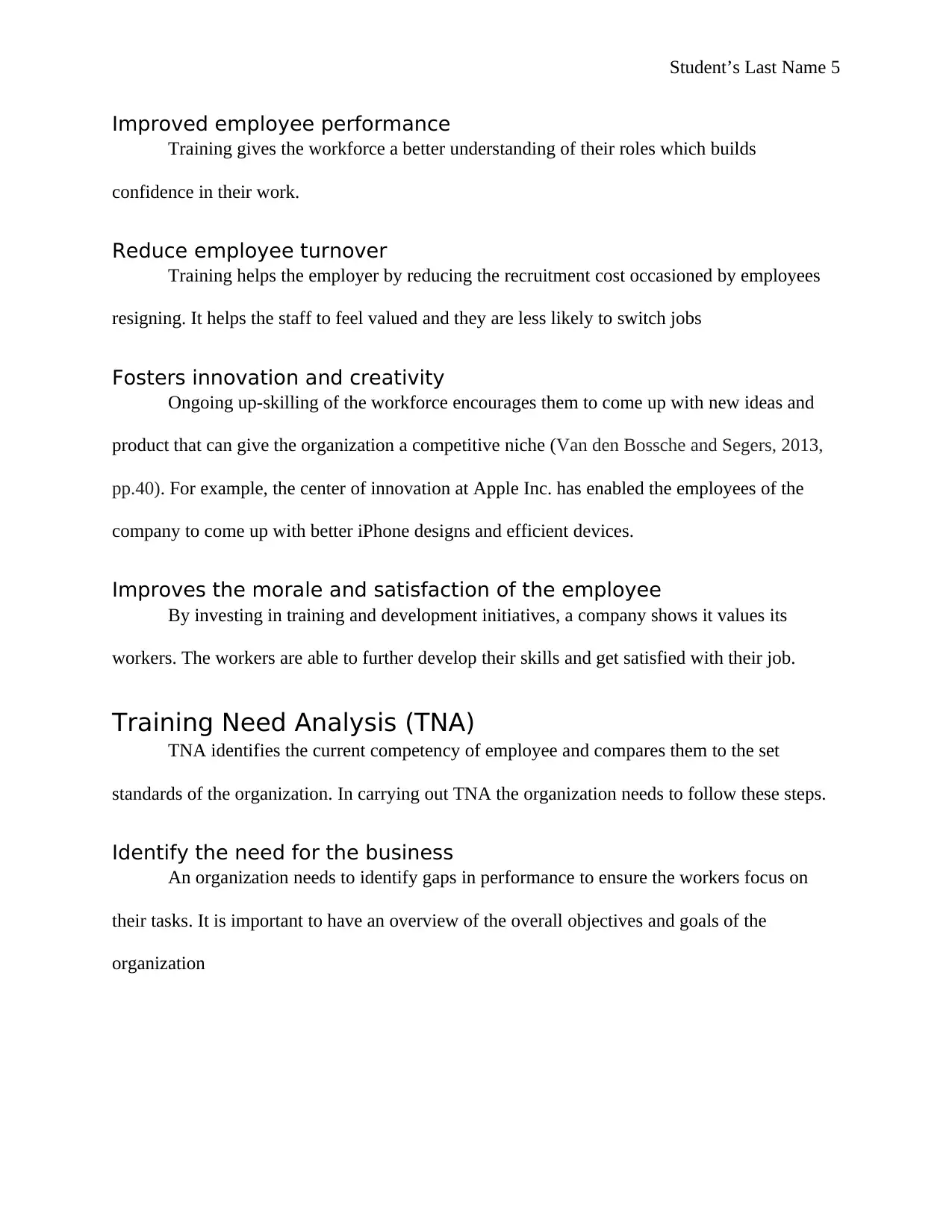
Student’s Last Name 5
Improved employee performance
Training gives the workforce a better understanding of their roles which builds
confidence in their work.
Reduce employee turnover
Training helps the employer by reducing the recruitment cost occasioned by employees
resigning. It helps the staff to feel valued and they are less likely to switch jobs
Fosters innovation and creativity
Ongoing up-skilling of the workforce encourages them to come up with new ideas and
product that can give the organization a competitive niche (Van den Bossche and Segers, 2013,
pp.40). For example, the center of innovation at Apple Inc. has enabled the employees of the
company to come up with better iPhone designs and efficient devices.
Improves the morale and satisfaction of the employee
By investing in training and development initiatives, a company shows it values its
workers. The workers are able to further develop their skills and get satisfied with their job.
Training Need Analysis (TNA)
TNA identifies the current competency of employee and compares them to the set
standards of the organization. In carrying out TNA the organization needs to follow these steps.
Identify the need for the business
An organization needs to identify gaps in performance to ensure the workers focus on
their tasks. It is important to have an overview of the overall objectives and goals of the
organization
Improved employee performance
Training gives the workforce a better understanding of their roles which builds
confidence in their work.
Reduce employee turnover
Training helps the employer by reducing the recruitment cost occasioned by employees
resigning. It helps the staff to feel valued and they are less likely to switch jobs
Fosters innovation and creativity
Ongoing up-skilling of the workforce encourages them to come up with new ideas and
product that can give the organization a competitive niche (Van den Bossche and Segers, 2013,
pp.40). For example, the center of innovation at Apple Inc. has enabled the employees of the
company to come up with better iPhone designs and efficient devices.
Improves the morale and satisfaction of the employee
By investing in training and development initiatives, a company shows it values its
workers. The workers are able to further develop their skills and get satisfied with their job.
Training Need Analysis (TNA)
TNA identifies the current competency of employee and compares them to the set
standards of the organization. In carrying out TNA the organization needs to follow these steps.
Identify the need for the business
An organization needs to identify gaps in performance to ensure the workers focus on
their tasks. It is important to have an overview of the overall objectives and goals of the
organization
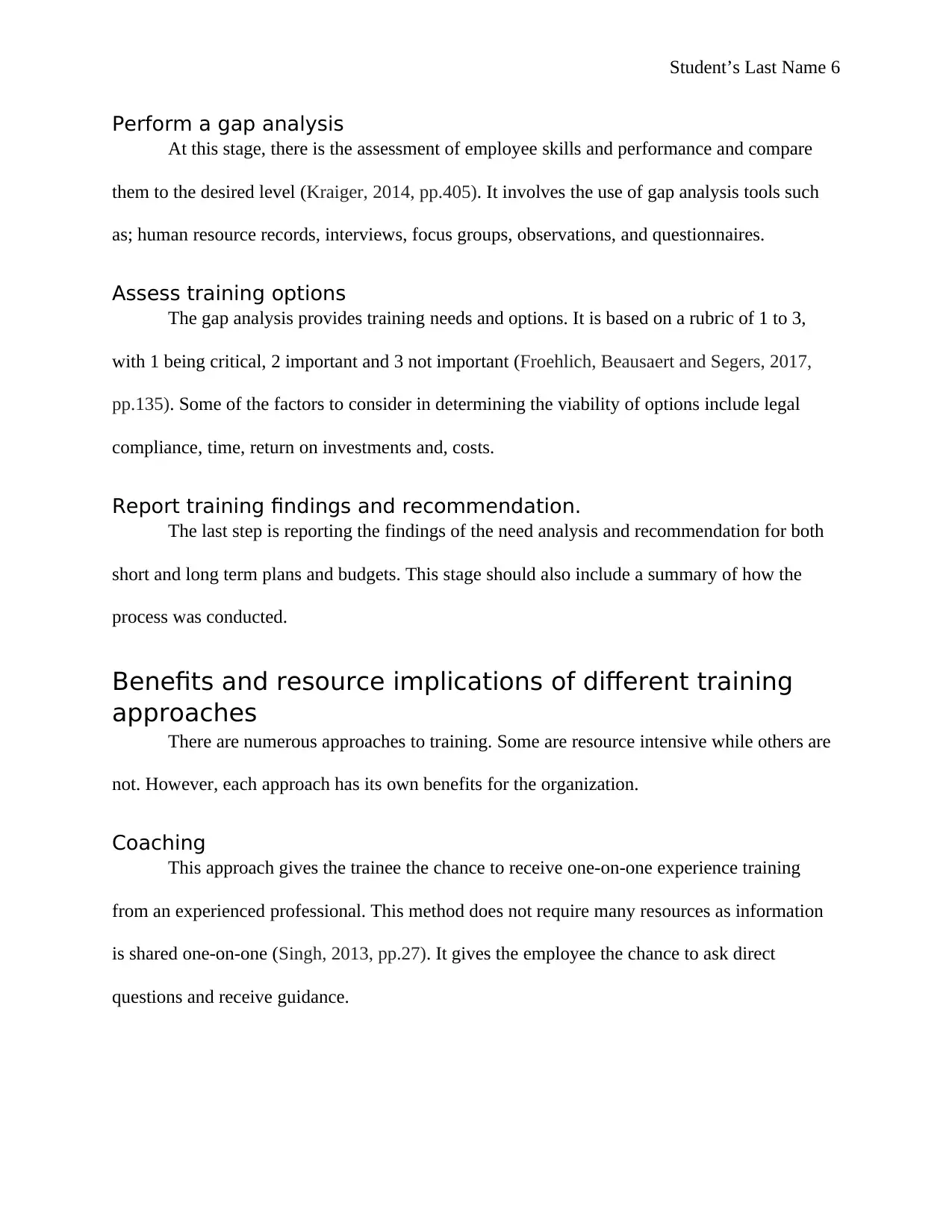
Student’s Last Name 6
Perform a gap analysis
At this stage, there is the assessment of employee skills and performance and compare
them to the desired level (Kraiger, 2014, pp.405). It involves the use of gap analysis tools such
as; human resource records, interviews, focus groups, observations, and questionnaires.
Assess training options
The gap analysis provides training needs and options. It is based on a rubric of 1 to 3,
with 1 being critical, 2 important and 3 not important (Froehlich, Beausaert and Segers, 2017,
pp.135). Some of the factors to consider in determining the viability of options include legal
compliance, time, return on investments and, costs.
Report training findings and recommendation.
The last step is reporting the findings of the need analysis and recommendation for both
short and long term plans and budgets. This stage should also include a summary of how the
process was conducted.
Benefits and resource implications of different training
approaches
There are numerous approaches to training. Some are resource intensive while others are
not. However, each approach has its own benefits for the organization.
Coaching
This approach gives the trainee the chance to receive one-on-one experience training
from an experienced professional. This method does not require many resources as information
is shared one-on-one (Singh, 2013, pp.27). It gives the employee the chance to ask direct
questions and receive guidance.
Perform a gap analysis
At this stage, there is the assessment of employee skills and performance and compare
them to the desired level (Kraiger, 2014, pp.405). It involves the use of gap analysis tools such
as; human resource records, interviews, focus groups, observations, and questionnaires.
Assess training options
The gap analysis provides training needs and options. It is based on a rubric of 1 to 3,
with 1 being critical, 2 important and 3 not important (Froehlich, Beausaert and Segers, 2017,
pp.135). Some of the factors to consider in determining the viability of options include legal
compliance, time, return on investments and, costs.
Report training findings and recommendation.
The last step is reporting the findings of the need analysis and recommendation for both
short and long term plans and budgets. This stage should also include a summary of how the
process was conducted.
Benefits and resource implications of different training
approaches
There are numerous approaches to training. Some are resource intensive while others are
not. However, each approach has its own benefits for the organization.
Coaching
This approach gives the trainee the chance to receive one-on-one experience training
from an experienced professional. This method does not require many resources as information
is shared one-on-one (Singh, 2013, pp.27). It gives the employee the chance to ask direct
questions and receive guidance.
⊘ This is a preview!⊘
Do you want full access?
Subscribe today to unlock all pages.

Trusted by 1+ million students worldwide

Student’s Last Name 7
Simulators
This form imitates real work experience. Simulators are expensive and require resources
such as capital and instructors. However, they are critical for such industry such as airline to train
novice pilots. The benefit of a simulator is that it is effective because it recreates the work
environment.
Role-playing
Role-playing can best be used to equip employees with interpersonal and communication
skills. This method does not require many resources because it involves interactions between
employees (AlYahya and Norsiah, 2013, pp.16). For example, in the truck industry, the truck
driver can role play a situation whereby has been pulled over by a police officer and describe
how he can handle the situation.
Conclusion
From the foregone, training and development is critical in enabling success in business
operations. It motivates the workforce and ensures the quality of service. It is important for an
organization to identify the gaps that exist in performance and apply appropriate intervention
mechanisms. Such intervention can be analyzed by carrying out Training Needs Analysis.
Additionally, the leadership should establish a good approach for training and development.
s
Simulators
This form imitates real work experience. Simulators are expensive and require resources
such as capital and instructors. However, they are critical for such industry such as airline to train
novice pilots. The benefit of a simulator is that it is effective because it recreates the work
environment.
Role-playing
Role-playing can best be used to equip employees with interpersonal and communication
skills. This method does not require many resources because it involves interactions between
employees (AlYahya and Norsiah, 2013, pp.16). For example, in the truck industry, the truck
driver can role play a situation whereby has been pulled over by a police officer and describe
how he can handle the situation.
Conclusion
From the foregone, training and development is critical in enabling success in business
operations. It motivates the workforce and ensures the quality of service. It is important for an
organization to identify the gaps that exist in performance and apply appropriate intervention
mechanisms. Such intervention can be analyzed by carrying out Training Needs Analysis.
Additionally, the leadership should establish a good approach for training and development.
s
Paraphrase This Document
Need a fresh take? Get an instant paraphrase of this document with our AI Paraphraser
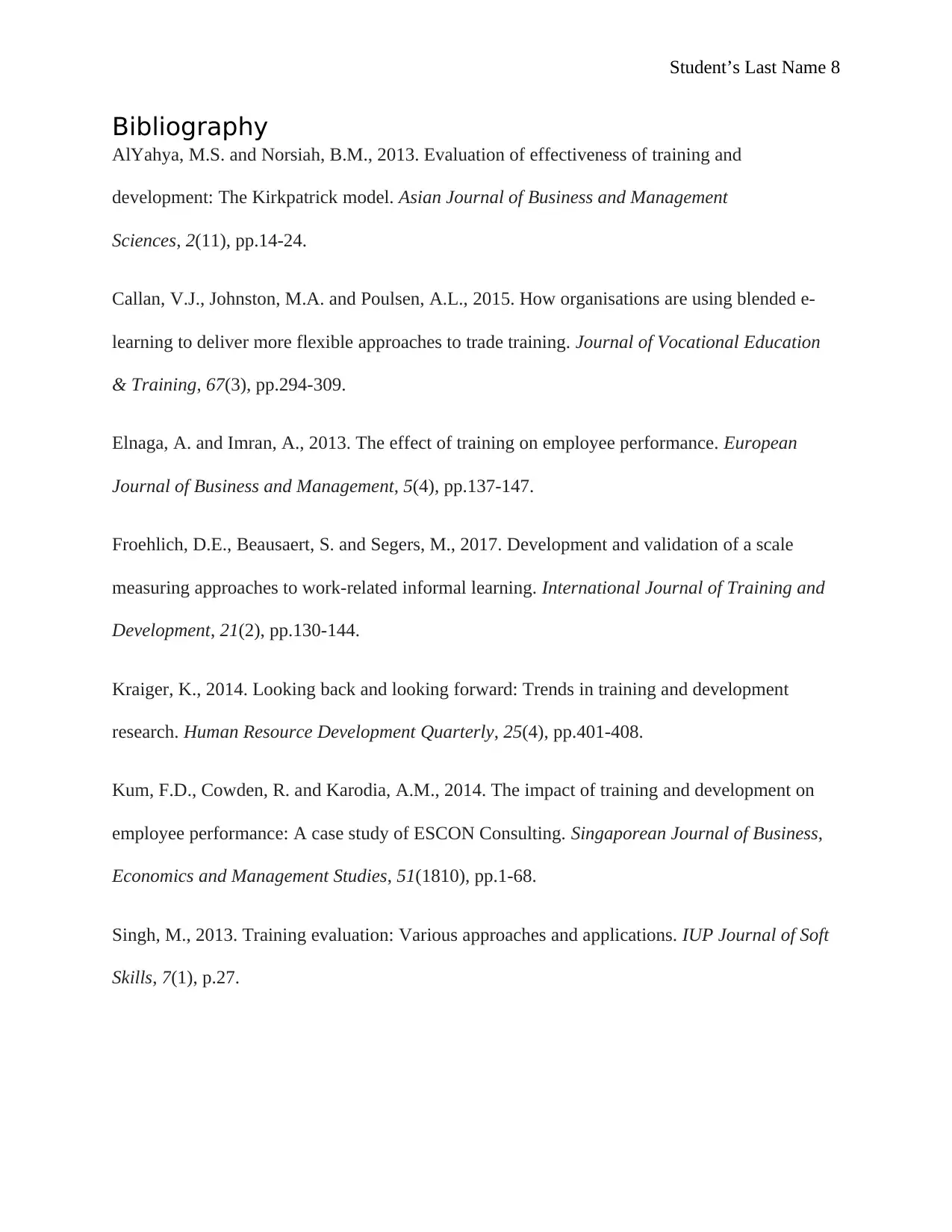
Student’s Last Name 8
Bibliography
AlYahya, M.S. and Norsiah, B.M., 2013. Evaluation of effectiveness of training and
development: The Kirkpatrick model. Asian Journal of Business and Management
Sciences, 2(11), pp.14-24.
Callan, V.J., Johnston, M.A. and Poulsen, A.L., 2015. How organisations are using blended e-
learning to deliver more flexible approaches to trade training. Journal of Vocational Education
& Training, 67(3), pp.294-309.
Elnaga, A. and Imran, A., 2013. The effect of training on employee performance. European
Journal of Business and Management, 5(4), pp.137-147.
Froehlich, D.E., Beausaert, S. and Segers, M., 2017. Development and validation of a scale
measuring approaches to work‐related informal learning. International Journal of Training and
Development, 21(2), pp.130-144.
Kraiger, K., 2014. Looking back and looking forward: Trends in training and development
research. Human Resource Development Quarterly, 25(4), pp.401-408.
Kum, F.D., Cowden, R. and Karodia, A.M., 2014. The impact of training and development on
employee performance: A case study of ESCON Consulting. Singaporean Journal of Business,
Economics and Management Studies, 51(1810), pp.1-68.
Singh, M., 2013. Training evaluation: Various approaches and applications. IUP Journal of Soft
Skills, 7(1), p.27.
Bibliography
AlYahya, M.S. and Norsiah, B.M., 2013. Evaluation of effectiveness of training and
development: The Kirkpatrick model. Asian Journal of Business and Management
Sciences, 2(11), pp.14-24.
Callan, V.J., Johnston, M.A. and Poulsen, A.L., 2015. How organisations are using blended e-
learning to deliver more flexible approaches to trade training. Journal of Vocational Education
& Training, 67(3), pp.294-309.
Elnaga, A. and Imran, A., 2013. The effect of training on employee performance. European
Journal of Business and Management, 5(4), pp.137-147.
Froehlich, D.E., Beausaert, S. and Segers, M., 2017. Development and validation of a scale
measuring approaches to work‐related informal learning. International Journal of Training and
Development, 21(2), pp.130-144.
Kraiger, K., 2014. Looking back and looking forward: Trends in training and development
research. Human Resource Development Quarterly, 25(4), pp.401-408.
Kum, F.D., Cowden, R. and Karodia, A.M., 2014. The impact of training and development on
employee performance: A case study of ESCON Consulting. Singaporean Journal of Business,
Economics and Management Studies, 51(1810), pp.1-68.
Singh, M., 2013. Training evaluation: Various approaches and applications. IUP Journal of Soft
Skills, 7(1), p.27.

Student’s Last Name 9
Sung, S.Y. and Choi, J.N., 2014. Do organizations spend wisely on employees? Effects of
training and development investments on learning and innovation in organizations. Journal of
organizational behavior, 35(3), pp.393-412.
Van den Bossche, P. and Segers, M., 2013. Transfer of training: Adding insight through social
network analysis. Educational Research Review, 8, pp.37-47.
Webb, J. and Chaffer, C., 2016. The expectation performance gap in accounting education: A
review of generic skills development in UK accounting degrees. Accounting Education, 25(4),
pp.349-367.
Sung, S.Y. and Choi, J.N., 2014. Do organizations spend wisely on employees? Effects of
training and development investments on learning and innovation in organizations. Journal of
organizational behavior, 35(3), pp.393-412.
Van den Bossche, P. and Segers, M., 2013. Transfer of training: Adding insight through social
network analysis. Educational Research Review, 8, pp.37-47.
Webb, J. and Chaffer, C., 2016. The expectation performance gap in accounting education: A
review of generic skills development in UK accounting degrees. Accounting Education, 25(4),
pp.349-367.
⊘ This is a preview!⊘
Do you want full access?
Subscribe today to unlock all pages.

Trusted by 1+ million students worldwide
1 out of 9
Related Documents
Your All-in-One AI-Powered Toolkit for Academic Success.
+13062052269
info@desklib.com
Available 24*7 on WhatsApp / Email
![[object Object]](/_next/static/media/star-bottom.7253800d.svg)
Unlock your academic potential
Copyright © 2020–2025 A2Z Services. All Rights Reserved. Developed and managed by ZUCOL.





